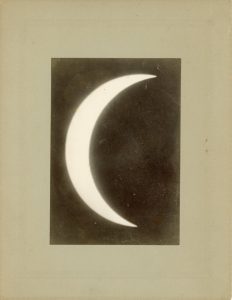“Eclipse Was On Time:” 1900 Solar Eclipse
On April 8 there will be a total eclipse of the sun and Geneva will be in the path of totality. Over the past 124 years Genevans have experienced a total solar eclipse only two other times – May 28, 1900, and January 24, 1925.
Below is a newspaper account of the 1900 eclipse. Astronomer Dr. William Brooks lived and worked in Geneva from 1887 until his death in 1921. In 1900 he viewed and documented the solar eclipse.
(From the Geneva Daily Times, May 28, 1900)
Eclipse Was On Time
Many Genevans Viewed the Phenomenon.
Dr. William R. Brook Tells of the Results of His Observations Today.
The eclipse in Geneva was on time. It was viewed by hundreds of persons through smoked glass and Dr. William R. Brooks and a few others through the big telescope at Smith observatory.
Several amusing incidents occurred here during the eclipse, which serve to further illustrate the superstitions still entertained by persons of a low order of intellect concerning an eclipse, as told of in a Madrid dispatch today. Several Italians at work along the Lehigh tracks when the greatest obscuration took place were badly scared. They knelt on the ground and bowed their heads. Another Italian well known in this city went to the rear of a peanut shop and knelt in prayer. He said the eclipse was a manifestation of the devil.
Dr. William R. Brooks successfully observed the phenomenon and secured some excellent photographs. He said to a TIMES reporter this afternoon:

Eclipse of the Sun May 28th, 1900. Greatest obscuration at Geneva New York. Photographed by William Brooks at the Smith Observatory
“The weather conditions were very good, the air being still, giving remarkably good telescopic images. Very light clouds occasionally passed before the sun, but at the time of first and last contacts, the sky in the region of the sun was free from clouds and good observations were made, the contacts being quite close to the predicted times. The moment of greatest obscuration was estimated to be at 9h, 2m, 46s., and for some time before and after this period, the light was peculiar – sufficiently so to attract the attention of almost every person. The landscape had a weird, yellowish-green appearance and the sky had changed from blue to the color of pale smoked glass.”
A valuable series of photographs of the eclipse in all its phases was secured with the fine telescope of the Smith observatory, with photographic attachments invented and constructed by Dr. Brooks. By means of an additional eclipse lens placed over the visual objective and by attachments to the eye-end of the tube, the telescope is converted into an immense photographic camera over 12 feet in length.
“The diameter of the sun’s image first formed by the objective is one inch,” said Dr. Brooks,” but this primary image is enlarged by an achromatic lens, to four and one half inches in diameter upon the photographic plate. In photographing the sun very short exposures have to be made. The shutter has a narrow slit, about the width of a visiting card in thickness and this narrow slit is flashed across the focal plane in a about one one-hundredth of a second.”
An ingenious plan is used by Dr. Brooks to release this shutter without jarring the telescope. The shutter is held back an by a strong thread, and this is cut, or better, burned in two, when the exposure is made.
“Sometimes,” said the doctor, “I make the sun burn the thread through a burning glass so that the sun makes the exposure that photographs its own image.”
An attempt was made by Dr. Brooks to photograph the corona by a method devised by him some time age. It is well known that this has only been done where the eclipse was total. The astronomer placed an artificial moon close to the focal plane, with the purpose of cutting off the small remaining crescent of the sun as seen here. Unfortunately the sun was surrounded by light clouds during the time of the greatest eclipse. At some future time it is believed that an image of the corona may be secured in this manner.
Explore Dr. Brooks’ life and career further through Comet Finder: Dr. William R. Brooks, now on view at the Geneva History Museum through April 13 .

Thank you, John.
Dr Brooks was a true genius and the article is amazing and very interesting thinking of what was available 124 years ago.
Thanks John,
How timely. Learned more about Dr. Brooks. He was a real asset to the colleges and the Geneva community.